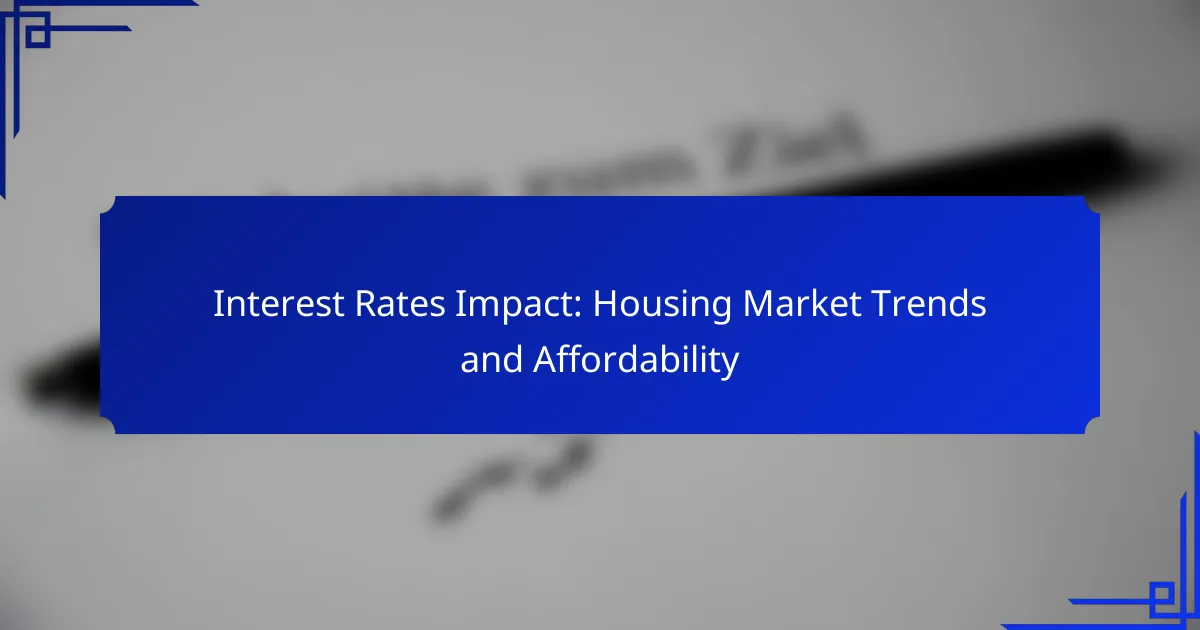Interest rates play a crucial role in shaping housing market trends, directly impacting borrowing costs and home affordability. As rates have surged to levels not seen in over a decade, many potential buyers are grappling with higher monthly payments, which can restrict their purchasing power and alter demand dynamics in the housing market.
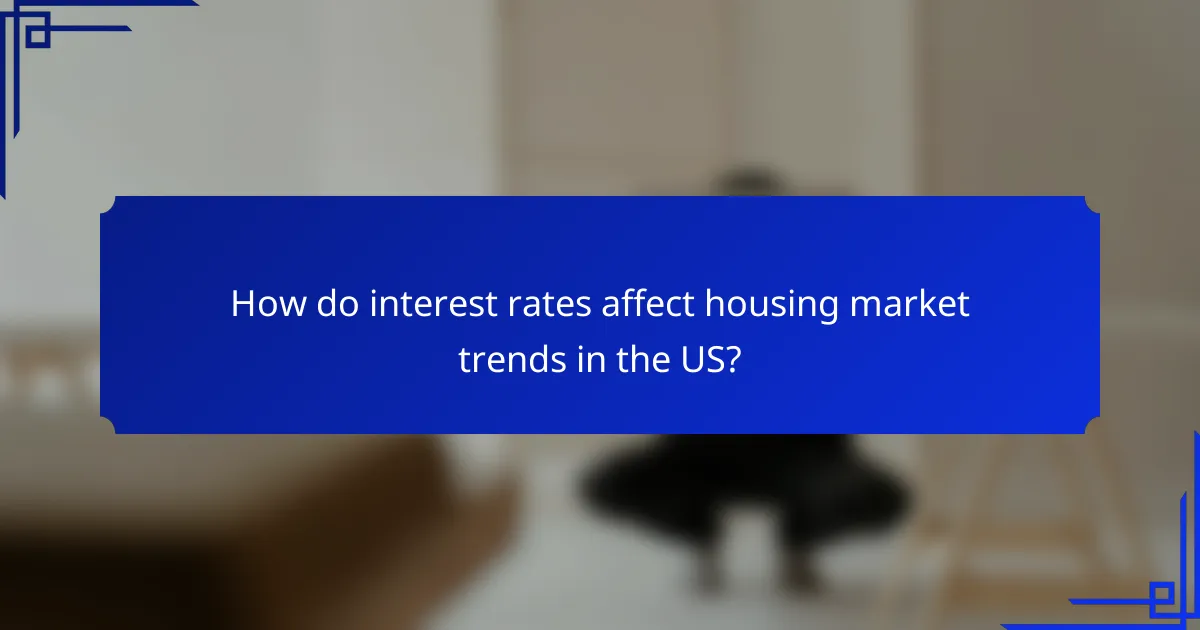
How do interest rates affect housing market trends in the US?
Interest rates significantly influence housing market trends in the US by affecting borrowing costs, home affordability, and buyer behavior. When rates rise, it generally leads to decreased demand for homes and shifts in market dynamics.
Increased borrowing costs
Higher interest rates lead to increased borrowing costs for homebuyers, making mortgages more expensive. For example, a 1% increase in interest rates can raise monthly payments by hundreds of dollars, impacting affordability for many buyers.
This rise in costs can deter potential buyers from entering the market, as they may find it challenging to meet their budget constraints. Consequently, many may opt to delay their purchase or seek less expensive properties.
Decreased home sales
As borrowing costs rise, home sales typically decline. Higher interest rates can lead to a slowdown in the housing market, as fewer buyers are willing or able to purchase homes at elevated prices.
In recent years, significant rate hikes have resulted in noticeable drops in home sales, often leading to longer listing times and increased inventory levels. Sellers may need to adjust their expectations and pricing strategies to attract buyers in a less favorable market.
Shift in buyer demographics
Rising interest rates can alter the demographics of homebuyers, with first-time buyers often being the most affected. Many younger buyers may find it difficult to afford homes, leading to a trend where older, more financially stable buyers dominate the market.
This shift can also result in increased demand for smaller, more affordable homes, as younger buyers seek options that fit their tighter budgets. Consequently, the market may see a greater emphasis on entry-level properties.
Impact on new construction
Higher interest rates can slow down new construction projects as developers face increased financing costs. This can lead to a decrease in the number of new homes being built, exacerbating existing housing shortages.
Additionally, builders may become more cautious, focusing on projects that are likely to sell quickly or at lower price points. This shift can further impact the overall housing supply and affordability in the market.
Changes in rental market dynamics
As homeownership becomes less accessible due to rising interest rates, more individuals may turn to renting, increasing demand in the rental market. This shift can drive up rental prices, making it harder for renters to find affordable options.
Landlords may respond to this increased demand by raising rents or investing in property improvements to attract tenants. Consequently, renters may face a competitive market, leading to longer search times and higher costs.
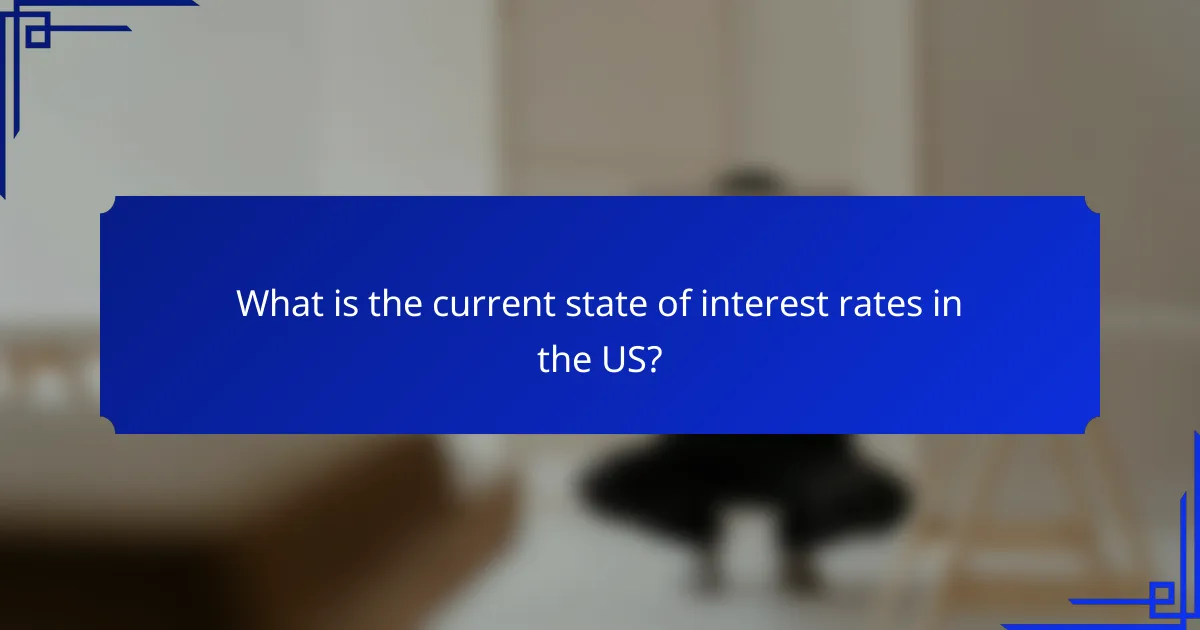
What is the current state of interest rates in the US?
The current state of interest rates in the US is characterized by a significant increase over the past few years, primarily driven by the Federal Reserve’s monetary policy aimed at combating inflation. As of late 2023, rates are at levels not seen in over a decade, impacting borrowing costs for consumers and businesses alike.
Federal Reserve rate adjustments
The Federal Reserve adjusts interest rates to influence economic activity, particularly to control inflation and stabilize the economy. Recent adjustments have seen rates rise sharply, with the Fed implementing several hikes in 2022 and 2023, reflecting a proactive stance against persistent inflationary pressures.
These adjustments directly affect the federal funds rate, which serves as a benchmark for various loans, including mortgages. Homebuyers and borrowers should monitor these changes, as they can significantly alter monthly payments and overall borrowing costs.
Current average mortgage rates
As of late 2023, the average mortgage rates for a 30-year fixed loan are hovering around the mid to high 7% range. This marks a notable increase compared to previous years when rates were often below 4%.
Higher mortgage rates can lead to increased monthly payments, making homeownership less affordable for many potential buyers. It’s essential for prospective homeowners to calculate their budget carefully and consider how these rates impact their purchasing power.
Historical comparison of rates
Historically, interest rates have fluctuated significantly. For instance, in the early 2000s, rates were often below 6%, while during the financial crisis, they dropped to record lows around 3% in 2020 and 2021. The current rates represent a stark contrast to those lows.
When comparing historical rates, it’s crucial to consider the broader economic context, including inflation rates and economic growth. Understanding these trends can help buyers make informed decisions about when to enter the housing market.
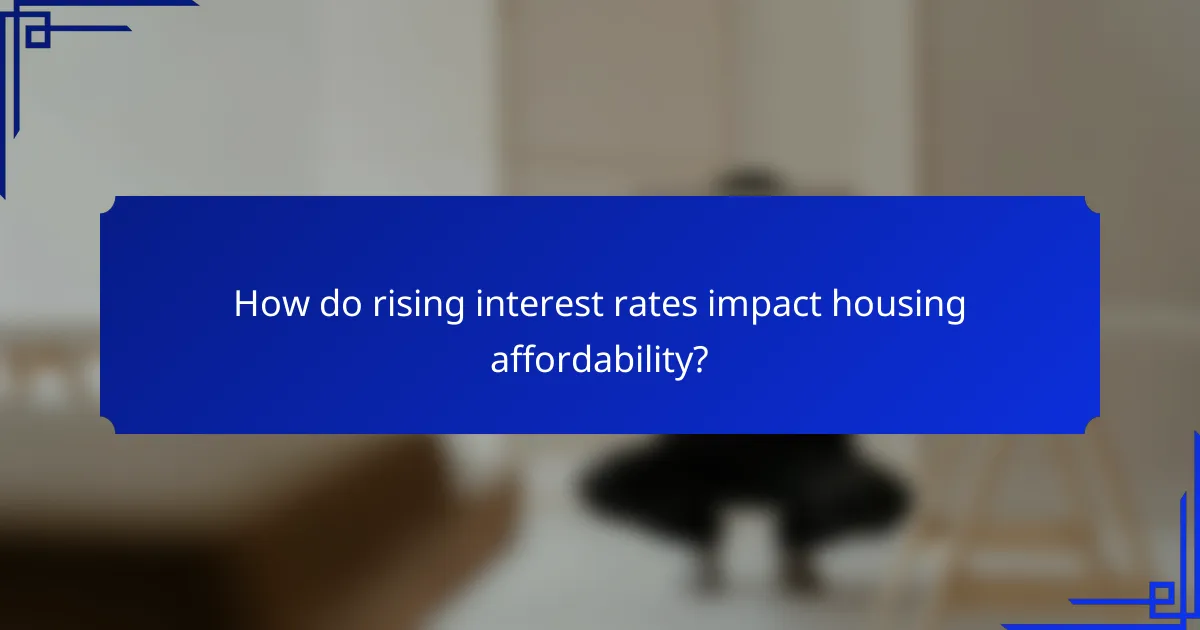
How do rising interest rates impact housing affordability?
Rising interest rates significantly affect housing affordability by increasing the cost of borrowing. As mortgage rates climb, potential homebuyers face higher monthly payments, which can limit their ability to purchase homes within their budget.
Higher monthly mortgage payments
When interest rates increase, the monthly mortgage payments for new loans rise correspondingly. For example, a 1% increase in interest rates can add hundreds of dollars to monthly payments on a typical mortgage, making homeownership less accessible for many buyers.
Higher payments can strain household budgets, leading some buyers to reconsider their purchasing decisions or opt for smaller homes. It’s crucial for potential buyers to calculate their affordability based on current interest rates to avoid financial strain.
Reduced purchasing power
As interest rates rise, the purchasing power of buyers diminishes. This means that buyers can afford less expensive homes than they could when rates were lower, limiting their options in the housing market.
For instance, if a buyer could afford a $300,000 home at a 3% interest rate, the same buyer might only be able to afford a $250,000 home at a 5% rate. This reduction can push buyers toward lower-priced neighborhoods or smaller properties.
Increased demand for affordable housing
With rising interest rates squeezing budgets, there is often a heightened demand for affordable housing options. More buyers are seeking homes that fit within tighter financial constraints, leading to increased competition in lower-priced segments of the market.
This surge in demand can drive up prices for affordable homes, making it even harder for low- and moderate-income families to find suitable housing. Communities may need to explore policies that support the development of affordable housing to meet this growing need.

What strategies can buyers use to navigate high interest rates?
Buyers can adopt several strategies to effectively navigate high interest rates, including exploring adjustable-rate mortgages, seeking government assistance programs, and negotiating closing costs. These approaches can help mitigate the financial impact of elevated borrowing costs and enhance affordability in the housing market.
Consider adjustable-rate mortgages
Adjustable-rate mortgages (ARMs) can be a viable option for buyers facing high interest rates. These loans typically offer lower initial rates compared to fixed-rate mortgages, which can result in significant savings during the early years of the loan. However, it’s essential to understand that rates may increase after the initial period, potentially leading to higher monthly payments.
When considering an ARM, evaluate the length of the fixed-rate period and the frequency of adjustments. For instance, a 5/1 ARM has a fixed rate for the first five years, after which it adjusts annually. This structure can be beneficial for buyers planning to move or refinance before the adjustment period begins.
Explore government assistance programs
Many government programs are available to assist buyers in managing high interest rates, particularly for first-time homebuyers. Programs like FHA loans or USDA loans often feature lower down payment requirements and more favorable terms, making homeownership more accessible even in a high-rate environment.
Research local and state-specific assistance programs that may offer grants or loans to help with down payments or closing costs. These programs can significantly reduce the upfront financial burden and improve overall affordability.
Negotiate closing costs
Negotiating closing costs can lead to substantial savings for buyers, especially when interest rates are high. Closing costs typically range from 2% to 5% of the loan amount, so reducing these fees can ease the financial strain. Buyers should feel empowered to discuss these costs with sellers or lenders.
Consider asking the seller to cover part of the closing costs as part of the purchase agreement. Additionally, shop around for lenders and compare their fees to find the most favorable terms. Being proactive in negotiations can lead to better financial outcomes in a challenging interest rate environment.
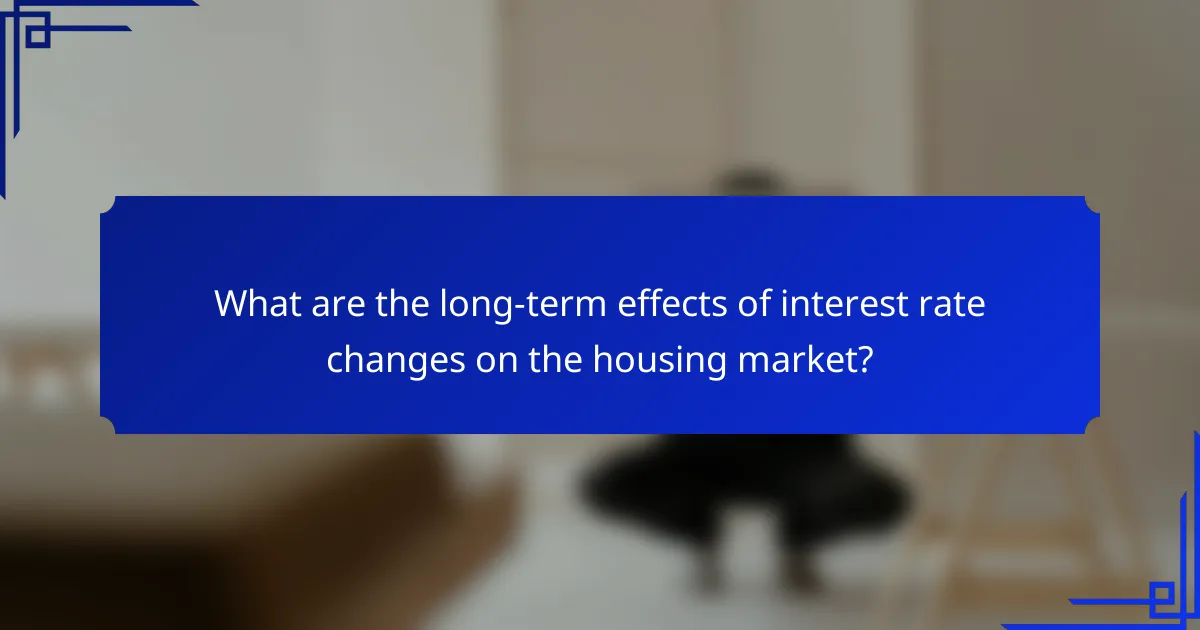
What are the long-term effects of interest rate changes on the housing market?
Long-term changes in interest rates significantly impact the housing market by influencing mortgage affordability and overall demand. Higher interest rates typically lead to increased borrowing costs, which can reduce homebuyer activity and slow down price growth.
Market stabilization trends
As interest rates stabilize, the housing market often experiences a period of adjustment where prices level off. This stabilization can encourage both buyers and sellers to enter the market, as uncertainty diminishes. For example, when rates are steady, potential homeowners may feel more confident in making long-term financial commitments.
Additionally, consistent interest rates can lead to a more predictable environment for real estate investors. They can better assess potential returns on investment properties, which may lead to increased activity in rental markets as well.
Potential for housing market corrections
When interest rates rise sharply, the housing market may face corrections, leading to decreased home values. Buyers may withdraw from the market due to higher monthly payments, resulting in a surplus of homes for sale. This oversupply can drive prices down, creating a buyer’s market.
In some cases, regions with rapidly increasing prices may see more significant corrections as affordability becomes a critical issue. Homebuyers should be mindful of their budget and consider the long-term implications of rising rates on their purchasing power. It’s essential to evaluate whether current price trends are sustainable in the face of potential interest rate hikes.
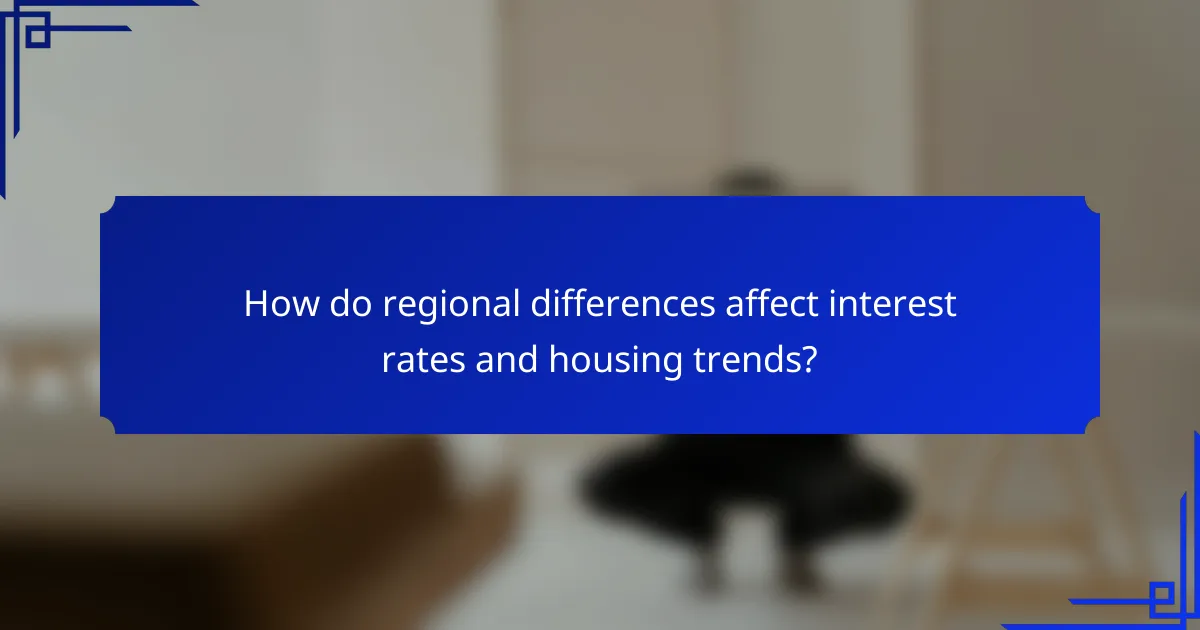
How do regional differences affect interest rates and housing trends?
Regional differences significantly influence interest rates and housing trends, as local economic conditions, demand, and regulations vary. These factors can lead to distinct housing market behaviors across different areas, affecting affordability and investment opportunities.
Variability across major US cities
Interest rates and housing trends can differ widely among major US cities due to local economic conditions, population growth, and housing supply. For instance, cities like San Francisco and New York often experience higher demand and prices, which can lead to elevated interest rates compared to cities with slower growth like Detroit or Cleveland.
In high-demand areas, the competition for housing can push prices up significantly, making affordability a pressing issue. Conversely, cities with a surplus of housing may see lower prices and interest rates, providing more opportunities for buyers. Understanding these dynamics is crucial for potential homeowners and investors.
When considering a purchase, it’s essential to research local market conditions, including average home prices and prevailing interest rates. Tools like online mortgage calculators can help gauge potential monthly payments based on current rates, allowing buyers to make informed decisions. Additionally, consulting local real estate experts can provide valuable insights into specific neighborhoods and market trends.
